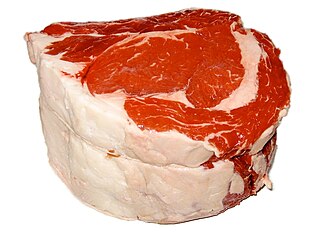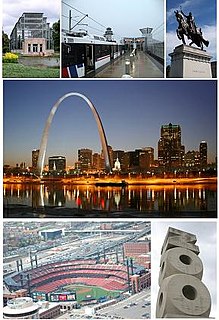
Beef is the culinary name for meat from cattle, particularly skeletal muscle. Humans have been eating beef since prehistoric times. Beef is a source of high-quality protein and nutrients.

Philip Danforth Armour Sr. was an American meatpacking industrialist who founded the Chicago-based firm of Armour & Company. Born on an upstate New York farm, he made $8000 in the California gold rush, 1852–56. He opened a wholesale grocery business in Cincinnati, then moved it to Milwaukee. He made millions selling meat to the United States Army during the Civil War. In 1875, he moved his base to Chicago. Armour's innovations including bringing live hogs to the metropolis for slaughter, inventing an assembly line system for the dis-assembly of hogs, canning the product, economy of scale and efficiency in detail. He systematically utilized waste products, boasting that he made use of "everything but the squeal". The introduction of refrigerated rail cars opened a national market for him and competitors such as Gustavus Swift. Armour expanded into banking and speculation on the futures market for pork and wheat by 1900, his plants employed 15,000 workers; his own wealth was in the range of $50 million. The urgent Army need for meat during the Spanish–American War of 1898 led to highly publicized complaints about "embalmed beef." Armour retired from business in 1899, and devoted himself to philanthropy in the Chicago area, including local cost housing for industrial workers, and the major institution of higher education, the Armour Institute of Technology.

A feedlot or feed yard is a type of animal feeding operation (AFO) which is used in intensive animal farming for finishing livestock, notably beef cattle, but also swine, horses, sheep, turkeys, chickens or ducks, prior to slaughter. Large beef feedlots are called concentrated animal feeding operations (CAFO) in the United States and intensive livestock operations (ILOs) or confined feeding operations (CFO) in Canada. They may contain thousands of animals in an array of pens.

Rendering is a process that converts waste animal tissue into stable, usable materials. Rendering can refer to any processing of animal products into more useful materials, or, more narrowly, to the rendering of whole animal fatty tissue into purified fats like lard or tallow. Rendering can be carried out on an industrial, farm, or kitchen scale.

Gustavus Franklin Swift, Sr. was an American business executive. He founded a meat-packing empire in the Midwest during the late nineteenth century, over which he presided until his death. He is credited with the development of the first practical ice-cooled railroad car, which allowed his company to ship dressed meats to all parts of the country and abroad, ushering in the "era of cheap beef." Swift pioneered the use of animal by-products for the manufacture of soap, glue, fertilizer, various types of sundries, and even medical products.

The Union Stock Yard & Transit Co., or The Yards, was the meatpacking district in Chicago for more than a century, starting in 1865. The district was operated by a group of railroad companies that acquired marshland and turned it into a centralized processing area. By the 1890s, the railroad money behind the Union Stockyards was Vanderbilt money. The Union Stockyards operated in the New City community area for 106 years, helping Chicago become known as "hog butcher for the world" and the center of the American meatpacking industry for decades.
The term meat industry describes modern industrialized livestock agriculture for production, packing, preservation and marketing of meat. In economics, it is a fusion of primary (agriculture) and secondary (industry) activity and hard to characterize strictly in terms of either one alone. The greater part of the entire meat industry is termed meat packing industry- the segment that handles the slaughtering, processing, packaging, and distribution of animals such as cattle, pigs, sheep and other livestock.

JBS USA Holdings, Inc. is an American food processing company and a wholly owned subsidiary of JBS S.A. (B3:JBSS3), a Brazilian company that is the world's largest processor of fresh beef and pork, with more than US$50 billion in annual sales as of 2017. The subsidiary was created when JBS entered the U.S. market in 2007 with its purchase of Swift & Company.
Horse slaughter is the practice of slaughtering horses to produce meat for consumption. Humans have long consumed horse meat; the oldest known cave art, the 30,000-year-old paintings in France's Chauvet Cave, depict horses with other wild animals hunted by humans. Equine domestication is believed to have begun to raise horses for human consumption. The practice has become controversial in some parts of the world due to several concerns: whether horses are managed humanely in industrial slaughter; whether horses not raised for consumption yield safe meat, and whether it is appropriate to consume a companion animal.

The Packers and Stockyards Act of 1921 was enacted following the release in 1919 of the Report of the Federal Trade Commission on the meatpacking industry.
The Union Stockyards of Omaha, Nebraska were founded in 1883 in South Omaha by the Union Stock Yards Company of Omaha. A fierce rival of Chicago's Union Stock Yards, the Omaha Union Stockyards were third in the United States for production by 1890. In 1947 they were second to Chicago in the world. Omaha overtook Chicago as the nation's largest livestock market and meat packing industry center in 1955, a title which it held onto until 1971. The 116-year-old institution closed in 1999. The Livestock Exchange Building was listed on the National Register of Historic Places in 1999.
Cargill Meat Solutions is a division of Cargill Inc. that comprises the company's North American beef, turkey, food service and food distribution businesses. The corporate office is located in Wichita, Kansas, United States. Jody Horner is the division's president.
William Davies Company was a pork processing and packing company in Toronto, Ontario, Canada. At one time, it was the largest pork packer in the British Empire, and it operated Canada's first major chain of food stores. One of Toronto's longstanding nicknames, "Hogtown", is attributable to the millions of pigs processed annually by the William Davies Company.
Hallmark/Westland Meat Packing Company was a California-based meat packaging company. It was forced into bankruptcy due to costs from a meat recall and ensuing litigation.
Swift & Co. v. United States, 196 U.S. 375 (1905), was a case in which the United States Supreme Court ruled that the Commerce Clause allowed the federal government to regulate monopolies if it has a direct effect on commerce. It marked the success of the Presidency of Theodore Roosevelt in destroying the "Beef Trust." This case established a "stream of commerce" argument that allows Congress to regulate things that fall into either category. In particular it allowed Congress to regulate the Chicago slaughterhouse industry. Even though the slaughterhouse supposedly only dealt with intrastate matters, the butchering of meat was merely a "station" along the way between cow and meat. Thus as it was part of the greater meat industry that was between the several states Congress can regulate it. The Court's decision halted price fixing by Swift & Company and its allies.
President Chester A. Arthur signed the Animal Industry Act on May 29, 1884 creating the Bureau of Animal Industry (BAI), an organization that was established under the United States Department of Agriculture. It replaced the Veterinary Division that had been created by the Commissioner of Agriculture in 1883, which had taken over for the Treasury Cattle Commission, Department of Treasury.
National City was a suburb of East St. Louis, Illinois. Incorporated in 1907, it was a company town for the St. Louis National Stockyards Company. In 1996, the company, which owned all residential property in the town, evicted all of its residents. The following year, because it had no residents, National City was dissolved by court order. Its site was subsequently annexed by nearby Fairmont City, Illinois.
In United States agricultural regulation, packer concentration refers to the degree to which a few large firms dominate total sales within segments of the meat packing industry, which, some farmers and other critics contend, can cause or at least contribute to lower prices for their animals. Market control by five large packers in the early 1900s led to passage of the Packers and Stockyards Act of 1921. Concentration declined after that, but has increased sharply in more recent years. According to USDA, for example, the four largest firms accounted for 82% of the steer and heifer slaughter in 2000, compared with 36% in 1980. Four-firm concentration in hog slaughter was 56% in 2000, compared with 34% in 1980. Numerous government-sponsored studies and investigations have been inconclusive on the relationship in recent years between concentration and prices.
Countries regulate the marketing and sale of beef by observing criteria of Cattle Carcasses at the Abattoir and classifying the carcasses. This classification, sometimes optional, can suggest a market demand for a particular animal's attributes and therefore the price owed to the producer.












